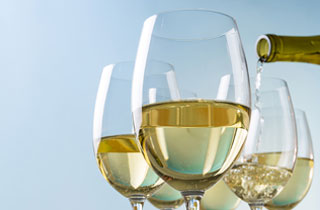It its simplest, degas means “to remove gas from.” While the practice can apply to any unwanted gas, we have a very specific objective in mind in winemaking. We mean to remove excess carbon dioxide (CO2) from a wine during production. Why we do this may be a bit more subtle than it looks at first glance. In deciding how to do it, the home winemaker has a range of choices from simple to sophisticated. And when to apply degassing will determine the ultimate success of the process and its effect on the wine.
Carbon dioxide is produced during fermentation. Here is a look at the generalized sugar fermentation by yeast as presented by Yair Margalit in Concepts in Wine Chemistry:
C6H12O6 – – – > 2CH3-CH2-OH + 2CO2
While there are many intermediate steps and side paths in the biochemistry of alcoholic fermentation, this shows the basic reaction. One six-carbon sugar molecule, like fructose or glucose, ends as two ethanol molecules and two carbon dioxide molecules. Since the sugar has a molecular weight of 180 g/mol and carbon dioxide is 44, the yield of 2 x 44 = 88 g/mol is equivalent to 49% of the original sugar becoming carbon dioxide. That is a very large amount of gas. Imagine a 20 °Brix must (20% sugar by weight) fermented to dryness. From one kilogram (2.2 lbs.) of that must, which would occupy less than 1 liter (1.1 qt) in volume, there would be 1 x 0.2 x 0.49 = 0.098 kg (98 g or 0.22 lb.) of gas. Using the ideal gas approximation, molar volume is 22.4 L (0.79 cu ft) at standard temperature and pressure. Our 98 g of gas is (98/44) = 2.23 moles, so that times 22.4 shows a production of 50 L (1.77 cu ft) of gas from every kilogram of must!
A second source of carbon dioxide in wine is malolactic fermentation. Bacteria convert malic acid into lactic acid, releasing CO2 along the way. According to Emile Peynaud in Knowing and Making Wine, each gram (0.035 oz.) of malic acid will produce 0.67 g (0.024 oz.) of lactic acid and 0.33 g (0.012 oz.) of carbon dioxide. Imagine a wine with 2.5 g/L (0.25 g/100 mL) of malic acid. In a complete malolactic fermentation, all 2.5 g would convert, yielding (2.5 x 0.33) = 0.82 g of CO2, occupying 0.42 L at standard temperature and pressure. Nowhere near as much as primary fermentation, but still about 40% of the volume of the wine it started in. One final, smaller source of carbon dioxide is from compressed gas deliberately added to provide a “blanket” on the wine or purging containers to retard oxidation.
The vast majority of fermentation carbon dioxide escapes into the atmosphere. As soon as the fermentations are complete, what remains is a water and ethanol solution (wine) saturated in carbon dioxide. The amount of carbon dioxide in that saturated solution is controlled by temperature, pH, alcohol content, and pressure inside the tank, carboy, or barrel. Zoecklein et al provide the following example in Wine Analysis and Production: “In wine of 11% alcohol (at atmospheric pressure), increasing the temperature from 0 °C to 20 °C (32 °F to 68 °F) brings about a solubility decrease from 2.9 to 1.4 g/L (2,900 to 1,400 mg/L).” Even at levels approaching 3,000 mg/L, this is a tiny fraction of the gas produced in primary fermentation.
We can compare saturation levels to sensory levels to get the “why” of degassing. Peynaud cites the optimal range for residual carbon dioxide in wine as from 300 to 600 mg/L. He goes on to explain that higher levels may seem too “piquant” and lower levels seem insipid. High levels of carbon dioxide enhance the sharpness of acidity and tannins, making red wines too harsh. On the other hand, higher levels in fresh, young white or rosé wines may provide a pleasant “lift.” Zoecklein notes, “Carbon dioxide is perceptible in water at 200 mg/L, and in wine at about 500 mg/L. At levels greater than 700 mg/L, CO2 may be tactically perceivable and greater than 1,000 mg/L, CO2 bubble formation is frequently noted.” We are looking, then, for final carbon dioxide levels in our wines above 300 mg/L but below about 700 mg/L to avoid a “spritzy” impression or exaggeration of acids and tannins.
While home winemakers primarily rely on sensory evaluation to choose degassing, commercial wineries face specific quantitative limits. Sparkling wines face higher tax rates than do still wines and the legal difference is quantitative carbon dioxide concentration. In the US, “still” wine must go to market with no more than 3.92 g/L (3,920 mg/L) while the OIV in the European Union sets a limit of 1.0 g/L (1,000 mg/L). To measure CO2, wine laboratories have a choice of methods. Enzymatic analysis is direct and efficient, but requires a spectrophotometer and specific reagents that are out of reach of most home winemakers. The Titrimetric Determination described in Zoecklein could probably be set up and run by a technically-minded home winemaker, but it is elaborate and complex. By far the simplest method is the Carbodoseur. A measured volume of wine at a specified temperature is placed in a special cylinder and sealed. After vigorous shaking, the released carbon dioxide is allowed to expel some of the wine (I have used this device, and yes, it was messy). The volume remaining is compared to a chart to estimate the CO2 concentration. A Carbodoseur is available from Scott Laboratories or Enartis Vinquiry for about $250.
To answer the “how” question of degassing, one approach is to execute conventional winemaking procedures over an extended time. Wine in oak barrels will lose carbon dioxide faster than in tank or carboy. Racking or filtering of wine will drive out some CO2, potentially leaving an acceptably low level without further intervention. If you do not have the time for that or it does not yield satisfactory results, three methods of direct degassing are stirring, vacuum application, and purging with inert gas.
Stirring is a simple technique, but it must be done vigorously to have the best effect. In Techniques in Home Winemaking, Daniel Pambianchi recommends stirring vigorously two or three times a day until there is no perceptible gas. Kit wine producers often specify vigorous stirring procedures. Using a long-handled spoon will require stirring for at least two minutes. Using a wine stirrer in a portable drill can shorten that time. These stirrers are plastic or stainless steel rods with hooks or wings at the end. The rod chucks into a battery-powered drill, the working end is inserted into a carboy or demijohn, and you run the drill. Do this for only a couple of seconds the first time; too much stirring too soon may cause the wine to foam out. Stirrers range from The Whip or Clean Bottle Express plastic degassers at about $12–$15 to the stainless steel Mix-Stir at about $40.
The next technique is to apply vacuum. As noted, saturation depends on pressure. If you lower the pressure above the wine, gas will come out. Pambianchi notes that using this technique with a carboy requires leaving sufficient headspace to allow for vigorous shaking of the carboy as you work. Attach an electric vacuum pump and tubing to a cap or plug on the carboy, turn on the pump, and shake the carboy. Continue for several minutes until no further bubbles are detected. Electric vacuum pumps may be found online from $50 to $250. Some vacuum bottle fillers can be used for vacuum degassing as well. The Gas Getter or All in One Wine Pump are two products available to home winemakers for vacuum degassing.
Finally, you may purge with a gas like nitrogen or argon. Using a fritted stone or just a plastic tube, introduce gas at the bottom and continue the flow until foaming stops; typically several minutes. To avoid over-sparging, a gas blend like 85% nitrogen and 15% carbon dioxide will leave some level of CO2 in the wine.
With any degassing technique, you must be careful to avoid introducing air and causing oxidation. The steady evolution of carbon dioxide during aging provides some protection against the ingress of air. SO2 provides protection against oxidation, but it is another gas that may be removed along with carbon dioxide during degassing. Monitor your sulfite levels and be prepared to make an addition after degassing. On the plus side, the reductive stink of rotten eggs is also caused by a gas: H2S, hydrogen sulfide. Removing it along with the carbon dioxide may result in a fresher, cleaner-smelling wine.
Those considerations generate the “when” answer to degassing. You may do it as soon after fermentation as you wish, but only when you are absolutely certain that all fermentation is complete. If it is not, you may need to degas again after some additional biological activity. Pambianchi advises to rack before degassing. If you do not, sediments may be put back into suspension, making a previously clear wine cloudy again. Since barrel aging or routine racking over several months may degas your wine, it is often prudent to wait until a few weeks before bottling to make the final decision. Whatever you decide, avoid going to bottle with excess carbon dioxide. Discovering a spritzy bottle means a big job ahead: Opening all the bottles of that batch, pouring them back into a carboy, and starting over at the beginning of this story!





